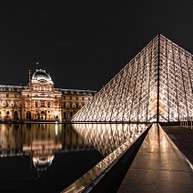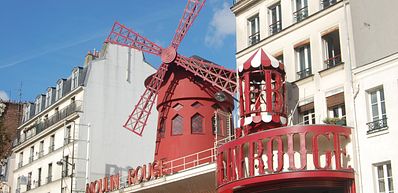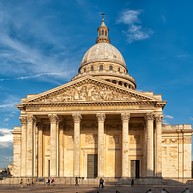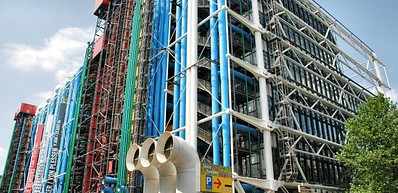
-
![The Luxembourg Palace in The Jardin du Luxembourg or Luxembourg Gardens in Paris, France. Luxembourg Palace was originally built (1615-1645) to be the royal residence of the regent Marie de Medici.]() Provided by: DaLiu/Shutterstock
Provided by: DaLiu/Shutterstock

Our travel guides are free to read and explore online. If you want to get your own copy, the full travel guide for this destination is available to you offline* to bring along anywhere or print for your trip.
*this will be downloaded as a PDF.Price
€4,95
Luxembourg Garden
The guide was updated:The Jardin du Luxembourg is one of Paris’s most beloved green spaces, situated in the 6th arrondissement and home to the French Senate. Commissioned by Marie de’ Medici in the 17th century, it’s a mix of manicured lawns, flowerbeds, fountains, and shady promenades. Locals come here to run, read, sail toy boats on the pond, or just sit and watch the world go by — from students and chess players to kids on the playground and politicians on their lunch break. The Luxembourg Palace sits at its centre, and the Medici Fountain remains one of its most photographed spots.
Useful Information
- Address: Boulevard Saint-Michel, Paris
- Website: jardin.senat.fr/en.html
- Public Transport: The closest RER station to the Jardin du Luxembourg is Luxembourg (RER B), with nearby Metro stations Odéon and Mabillon (Line 4 and 10).
Digital Travel Guide Download
Our travel guides are free to read and explore online. If you want to get your own copy, the full travel guide for this destination is available to you offline* to bring along anywhere or print for your trip.
*this will be downloaded as a PDF.Price
€4,95

Rising 324 metres above Paris, the Eiffel Tower was unveiled in 1889 as part of the World’s Fair celebrating 100 years since the Revolution. Though controversial at first for its unusual, industrial look — many Parisians felt it clashed with the city’s classic architecture and called it an eyesore — it quickly became the city’s defining symbol. Today, nearly 7 million visitors a year come for the views, to snap that classic photo, and to experience standing atop one of the world’s most unforgettable landmarks.
Read more

Louvre Museum
The Louvre is one of the world’s biggest museums and home to some of the most famous artworks you’ll ever see — think the Mona Lisa and Venus de Milo, alongside pieces by Rembrandt, Vermeer, and Caravaggio. Its glass pyramid entrance is instantly recognisable. Inside, you’ll find around 35,000 paintings, sculptures, and objects, covering everything from ancient civilisations to 19th-century art.
Read more

Arc de Triomphe
The Arc de Triomphe, commissioned by Napoleon after his win at Austerlitz in 1806, took about 30 years to finish and was finally opened in 1836. Standing 50 metres tall, it sits at the centre of Place Charles de Gaulle, right at the western end of the famous Champs-Élysées. You’ll probably find yourself there at some point, as most visitors wander down this iconic avenue. The monument honours those who fought and died for France during the Revolution and Napoleonic Wars. Beneath it rests the Tomb of the Unknown Soldier from World War I.
Bookable
Read more

Notre-Dame Cathedral of Paris
Notre-Dame stands on Île de la Cité, often called the birthplace of Paris. The site has been sacred for thousands of years—long before the cathedral, there were Celtic worship spots, then Roman temples, followed by a Romanesque church. The Gothic cathedral we see today was completed in 1345 and became the heart of medieval Paris. Despite the fire in 2019 that damaged much of it, the main structure and most treasures survived. It stretches 128 metres long with two towers rising 69 metres high, still commanding the city’s skyline.
Read more

Montmartre
Montmartre is one of Paris’s most charming and bohemian neighbourhoods, crowned by the white-domed Sacré-Cœur at the city’s highest point. Once home to artists like Dalí, Monet, and Picasso, its streets are still alive with painters and caricaturists, especially around Place du Tertre. Fans of Amélie will recognise many corners, and downhill in Pigalle you’ll find the iconic Moulin Rouge and the Lapin Agile, a historic cabaret that once drew poets, painters, and singers.
Read more

Sacré-Cœur Basilica
Perched atop Montmartre, the highest point in Paris, Sacré-Cœur’s white domes are visible for miles. Built in the late 19th and early 20th centuries, it houses one of the world’s largest mosaics and offers sweeping views from its dome. The steps out front are a favourite place to gather, especially at sunset.
Read more

Moulin Rouge
A trip to Paris is not complete without a visit to the legendary Moulin Rouge. Since 1889, this iconic Parisian landmark has held the title of the most famous cabaret in the world, thanks to its French can-can and the larger-than-life shows featuring expertly choreographed dancing, elaborate sets, and glamorous costumes. Sip on French Champagne, enjoy dinner in a beautiful Belle Époque venue, and experience the show Féerie, which you are sure to remember for years to come.
Bookable
Read more

Seine River Cruise
Boat cruises on the Seine embark at the foot of the Eiffel Tower and take you through the heart of Paris, where you can admire the prestigious monuments and landmarks of the city and the stunning architecture from bridge to bridge and bank to bank.
To learn history along the way, plug in your audio guide and choose your language. Come back at night for another tour, and it will be a different Paris before your eyes, yet just as magical.
Bookable
Read more

Palace of Versailles
The town of Versailles is a wealthy Parisian suburb and municipality, located 20 kilometres outside the city. In the 11th century, Versailles was merely a country village enveloping a castle and the church of Saint-Julien. Today, it is mostly known for the lavish Château de Versailles, which served as home to King Louis XIV and the summer palace to Napoleon. It also saw the historic signing of the Treaty of Versailles in 1919 in the now-legendary Hall of Mirrors.
Read more

Musée d’Orsay
Housed in a former railway station, the Musée d'Orsay holds a mesmerising collection of mainly French paintings, sculptures, and photography, including the world's largest collection of impressionist and post-impressionist paintings, with works from artists such as Van Gogh, Cézanne, Renoir, and Monet.
Read more

Catacombs of Paris
Installed in the tunnels of former quarries, in the heart of Paris, the Catacombs are at once a fascinating and eerie attraction. Walk down the many steps to experience this spooky underground cemetery. Here you will find the osseous remains of more than 6 million people, moved to this location from an old cemetery.
Read more

Disneyland Paris
If you’re ready to swap Paris’s romantic boulevards for a different kind of magic, head to Disneyland Paris. The resort has two parks: Disneyland Park, packed with rides, shows, restaurants, cafés, and endless shops; and Walt Disney Studios Park, which adds movie sets, live performances, and behind-the-scenes fun to the mix. Stroll down Main Street, U.S.A., set sail for Adventureland, or meet your favourite characters in Fantasyland. Whether you’re a kid, a grown-up, or somewhere in between, there’s more than enough here to keep the magic alive all day.
Bookable
Read more

Panthéon
Originally built as a church to house the reliquary of Saint Genevieve, this neoclassical building in the Latin Quarter, modelled after the Pantheon in Rome, is the final resting place of numerous writers, philosophers, poets and scientists, such as Rousseau, Voltaire, Victor Hugo, Émile Zola, and Marie Curie.
Bookable
Read more

Place de la Concorde
Place de la Concorde is an expansive square located at the eastern end of the Champs-Élysées. It holds historical importance for several reasons: the liberation struggle during World War II brought many battles to Place de la Concorde; during the French Revolution, over a thousand people were beheaded here, many of them famous: Louis XVI, Marie Antoinette, and revolutionary Robespierre, to name a few. The site is dominated by the 24-metre Obélisque de Louxor, one of Cleopatra's needles - a gift from Egyptian viceroy Mohammed Ali to Louis Philippe.
Bookable
Read more

Centre Pompidou
The Centre Pompidou stands out with its bold, high-tech design — pipes and escalators on the outside make it hard to miss. Inside, you’ll find Europe’s largest modern art museum, a big public library, and a hub for music and sound research. When it was built, many Parisians hated it for clashing with the classic city vibe, and its construction meant knocking down the famous Les Halles market nearby. Now, it’s a lively spot for art lovers and anyone curious about something a bit different.
Bookable
Read more

Père Lachaise Cemetery
Père Lachaise is the largest cemetery in Paris and is reputed to be the most visited in the world. It is a huge and peaceful park and the final resting place of many Frenchmen and foreigners who have enriched French life over the past 200 years, including Edith Piaf, Oscar Wilde, Camille Pissarro, Marcel Proust, Molière, Max Ernst, Maria Callas, and Jim Morrison, to name just a few.
Bookable
Read more

Champs-Élysées
The Champs-Élysées stretches nearly two kilometres from Place de la Concorde up to Place Charles de Gaulle, where the Arc de Triomphe stands tall. It’s a great spot for a stroll any time of year and comes alive during major celebrations like Bastille Day or New Year’s Eve. Each July, the final stage of the Tour de France races down this famous avenue.
Read more

Pont Neuf
Despite its name meaning 'New Bridge', Pont Neuf is actually Paris’s oldest bridge over the Seine, dating back to the 16th century. It’s also a great starting point to explore some of the city’s most famous sights. From here, you can easily wander around Île de la Cité to visit the Conciergerie, the old royal palace turned prison, and the stunning Sainte-Chapelle with its incredible stained glass windows. Just across the river lies the Louvre Museum, while a short walk takes you to the peaceful Place Dauphine, a hidden gem of a square. And, of course, the iconic Notre-Dame Cathedral is also close by.
Read more

Montparnasse Tower
Montparnasse Tower stands out as the only skyscraper in central Paris, reaching 210 metres high. Head up to the 56th-floor observation deck for clear, wide views of the city’s landmarks — the Eiffel Tower, the Louvre, Notre-Dame, and more. With its modern design and a quick elevator ride, Montparnasse Tower provides an alternative viewpoint for those seeking an awe-inspiring Parisian experience beyond the traditional cityscape.
Bookable
Read more

Le Marais
Le Marais, on the Right Bank in the 3rd and 4th arrondissements, mixes old and new with its 17th-century buildings and trendy vibe. It’s a lively area known for its museums, galleries, quirky shops, and buzzing nightlife. You'll also find plenty of kosher restaurants and historic spots like Place des Vosges — Paris’s oldest square — where the writer Victor Hugo once lived. Plus, it’s a hub for the city’s LGBT community, making it one of Paris’s most colourful neighbourhoods.
Read more

The River Seine
The Seine cuts through the heart of Paris, and seeing the city from the water is one of the easiest ways to take in its big-name sights — from the Eiffel Tower to Notre-Dame. A veritable Parisian institution since 1949, the Compagnie des Bateaux Mouches® runs cruises year-round, with most following a similar route and offering multilingual commentary. Whether you go for a daytime ride or a nighttime cruise when the bridges and monuments are lit up, it’s a relaxing way to see the city from a different angle.
Read more

Luxembourg Garden
The Jardin du Luxembourg is one of Paris’s most beloved green spaces, situated in the 6th arrondissement and home to the French Senate. Commissioned by Marie de’ Medici in the 17th century, it’s a mix of manicured lawns, flowerbeds, fountains, and shady promenades. Locals come here to run, read, sail toy boats on the pond, or just sit and watch the world go by — from students and chess players to kids on the playground and politicians on their lunch break. The Luxembourg Palace sits at its centre, and the Medici Fountain remains one of its most photographed spots.
Read more

Louis Vuitton Foundation
The Louis Vuitton Foundation is as much about the building as what’s inside. Designed by Frank Gehry, its glass sails and sweeping curves are worth the trip alone. Inside, you’ll find changing exhibitions of contemporary art from around the world, along with concerts, film screenings, and workshops.
Bookable
Read more

Cheese and Wine Workshops
Immerse yourself in the quintessential French art of making cheese at Paroles de Fromagers. Join a workshop that not only guides you through the art of making cheese but also offers an exquisite cheese and wine tasting session. Learn the craft of cheese-making firsthand and discover the perfect wine pairings for each variety — an absolutely great experience for gourmets.
Read more

Parc Montsouris
Parc Montsouris is one of four major parks created under Napoleon III at the edges of Paris. With its lake, waterfall, and wide lawns, it’s a year-round favourite for locals — whether for a picnic, a run, or just some quiet time outdoors.
Read more


